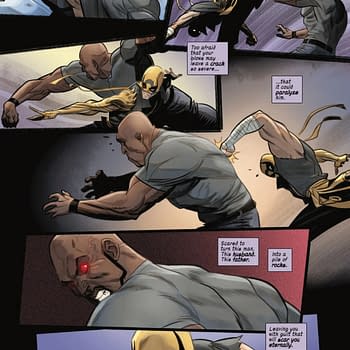Posted in: Comics, san diego comic con | Tagged: Barron Storey, Bill Sienkiewicz, Comics, dave mckean, David Mack, entertainment, film, grant morrison, Jason Shawn Alexander, Kent Williams, Ryan Graff, Stephanie Inagaki, Temple of Art
The Temple Of Art's Serious Star Power – McKean, Sienkiewicz, Mack, Morrison, And More At San Diego Comic Con
The Temple of Art is both a book and a documentary, and brought out a stellar group of panelists. John Shnepp hosted. Jason Shawn Alexander, Dave McKean, Kent Williams, David Mack, Bill Sienkiewicz, Grant Morrison, Stephanie Inagaki, Barron Storey, and Ryan Graff were some of the guests. The project has just launched its Kickstarter, and showing a trailer in the panel, we heard some of the questions posed by the documentary, like seeing art, asking "How does this beautiful thing happen?" And how do we talk about the "precarious life of a creative individual"?
Egos, muses, mystical experiences, came up, as well as living a life that "invites rejection" and rarely has a "plan B". The film is a "window" and a "gateway into art" and its relationship to the world. If making art is a battle, the participants in the video said, "I want to win". The film attempts to inspire viewers "to be curious". Many more artists are involved in the documentary than are present at the con, for instance Amanda Palmer and Neil Gaiman.
David Mack was asked why he is an artist and he explained that his mother was a teacher and as a kid he used to watch his mother making visual aids for her first grade students. Using art as an "access point to learn something" and seeing her "making" things influenced him. He realized she was making media to communicate, making art a language, and those are principles he still incorporates into his everyday life. He didn't necessarily want to be artist as a child, but maybe an actor or stuntman, but he got more positive reinforcement for his art.
Bill Sienkiewicz replied saying that art "infected" him and "chose" him. The first experience he had realizing there was something "different" about his calling. In kindergarten, he was asked to draw an Eskimo and kids came over afterward asking how he did it. His father wanted him to be an electrician, and he therefore got into wiring and sculpture, collage, and the like. Those were elements he initially felt he couldn't bring into comics, but finally asked "why not?" And that's a question that continues to this day.
Stephanie Inagaki had very encouraging parents in terms of creating things, and she can't imagine not doing art. She went to school for sculpture, but she's mainly into drawing and makes jewelry as well.
Kent Williams said that art was always a way to vent "pent up enthusiasm" for movies and comics. He'd get up early as a kid to collect bottles and get money, and then he'd have the money for a matinee Hammer Horror Film. His mother didn't know he was going to see those films.
Ryan Graff, the designer on the Temple of Art volume, went to school for illustrator, and was "ok" in that line, but felt he could be a "great designer" if he went for it. He feels there's plenty of design out there that's overbearing. Design is like a soundtrack in a film, and if you don't notice it, it works.
Jason Shawn Alexander's father drew a lot and it was a form of connection between them, and over time that's evolved into loving comics, experimenting with worlds, and realizing that images are now "immediate". He wants to get across things very quickly and a "picture is worth a thousand words".
Grant Morrison said he felt that it's incredibly important that parents encourage these inclinations. He was encouraged to make things because his family couldn't afford to buy things, and if he wanted a toy rocket, he'd have to make it out of a cereal box. At age 8, he drew a hundred pictures of Hitler in different clothes, confusing him a little with Charlie Chaplin. He was "lucky" in the sense that he grew up when Punk was happening. As long as you were making art, expressing yourself, it was welcome.
Dave McKean loved drawing as a child, but it was what "gave him pleasure", and looking at the evolutionary perspective on art, he thinks it's our "peacock feather", and where we show off. When he went to art school, what he really loved was the feeling of empathy with fellow students, getting to know them through their work. Art is an "empathy machine" he said. Most of his friends are in their 40's and 50's and have important jobs and aren't still drawing pictures. He's trying to figure out "where the importance is" and why art. He gets to look through the eyes of those who still do.
Jason Shawn Alexander was asked about the process of collaboration and seeing through others' eyes. There's something really fascinating about collaborating with someone who does the polar opposite of you and keeps you on your toes.
Dave McKean said that Grant Morrison was one of his first collaborators, and both at that time had reached a level where they knew they needed to branch out and change. They had a lunch where they broke out their ideas and he still remembers it. Working with Neil Gaiman has been so long that they've seen the worst of each other. Working with Richard Dawkins has been fascinating, and working with writer Ian Sinclair, doing films, talks, lectures, and comics. When they sat down to collaborate on a graphic novel or comic and he said "I don't really care if there are no words in it", which was unusual for a writer.
Barron Storey has a background in theater, and he realized from that experience how others saw things and how different his own thinking could be from others. It made him appreciate the "incredible creativity of others" and he's been teaching for a long time and the "shared energy" there is similar to collaboration.
Kent Williams working with John J. Muth on Wolverine found Muth's work ethereal and his more "gritty" and "earthy", and while working with Walter and Louis Simonson on the story as it went along, after about 1/2 of the first issue, they were butting heads too much. They got Walt and Louis to construct the storylines into parallel paths that would come back together to give each their own pages, and the solution was very rewarding. Working with Aronofsky when developing the movie The Fountain found Williams working on the graphic novel at the same time as the film was being made and working with the filmmaker on a regular basis.
Mack said that the energy from collaboration is important, and it's almost like a "third person is created". Most recently he's working on the new Fight Club comic project and he's worked with Brian Bendis in the past when Bendis was a penciller. When he got his first work on Marvel as a writer gave him the chance to introduce Bendis to Marvel and was able to work on a Daredevil project with him. Working on the credit sequence for Captain America: Winter Soldier involved interacting with a designer and created a "unique" experience timing things with music.
Sienkiewicz said that he tends to be more of an "isolationist" but has still had some major and rewarding collaborations, like working with Frank Miller and Alan Moore, who was very flexible and said he could change something in scripts, which is a little like being locked in a closet and being encouraged to play football, he laughed. The idea of collaborating with other artists is interesting to him, and the idea of collaborating with the other panelists there on the documentary makes him feel like he has to up his game, expand empathy, and deal with one's own ego. He feels he collaborates with the world and is influenced by everything that is out there.
Morrison is "really into" collaboration since he writes these days, and people like Frank Quitely, Cameron Stewart make it fresh for him and teach him things. He feels he couldn't live without it. He "needs great artists to bring to life things [he's] not capable of drawing" himself.
Here's the Kickstarter:



















